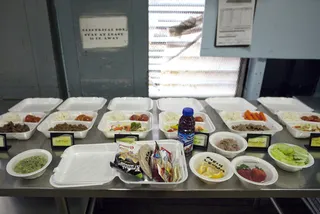Guantanamo on Strike
Obama calls for closure and the U.N. claims torture.

1 / 10
Guantánamo on Strike - This week the U.S. military has confirmed that the number of prisoners on hunger strike at the Guantánamo Bay military prison in Cuba has reached 100. In light of the heightened situation, BET.com takes a look at the strike and what might be next for the detainees. — Naeesa Aziz (Photo: AP Photo/Brennan Llinsley)

2 / 10
How Did This Start? - The strike began in February when a few detainees at the prison decided to refuse food as a way of protesting the fact that they had been held at the prison for an extended time (many for over 10 years) without being charged or allowed to have their cases decided in a trial. (Photo: Petty Officer 1st class Shane T. McCoy/U.S. Navy/Getty Images)

3 / 10
What’s Happening Now? - The U.S. military has confirmed that the number of detainees on strike has risen to 100 and lawyers for the strikers say the number is closer to 130. There are a total of 166 prisoners in the detention center. Unconfirmed reports say that nearly one-fifth of the hunger strikers are now being force-fed. (Photo: REUTERS/Bob Strong)
Photo By Photo: REUTERS/Bob Strong

4 / 10
President’s Response - President Obama spoke out about the strike for the first time recently, as news of the hunger strike continued to spread. Obama called for the closure of the prison, stating that, “It’s not sustainable. I mean, the notion that we’re going to continue to keep over 100 individuals in a no-man’s land in perpetuity.” (Photo: AP Photo/Pablo Martinez Monsivais)

5 / 10
What Is Guantánamo? - The Guantánamo Bay detention camp is a U.S. military facility used to detain and interrogate suspected opponents in the global war on terror. The detention center was established in 2002 under the Bush administration and is located on Guantánamo Bay Naval Base, Cuba.(Photo: AP Photo/Brennan Linsley, file)
ADVERTISEMENT

6 / 10
No Man’s Land - Although no new prisoners have arrived at Guantánamo over the past five years due to an Obama administration policy, no prisoners have been allowed to leave recently, but 86 have been cleared for release. (Photo: REUTERS/Bob Strong)

7 / 10
Congressional Blockage - The reason for the holdup at Guantánamo is Congress. Legislators have blocked the prisoners’ transfer to the U.S. to be tried or imprisoned, and also have conditioned the prisoners’ release to foreign countries upon security certification from the Secretary of Defense — a process that just simply has yet to happen. (Photo: Chip Somodevilla/Getty Images)

8 / 10
Force Fed - Reports say that about a fifth of the hunger strikers are now being force-fed, and many are being isolated in an effort to stop the strike. Although the government says that allowing the prisoners to starve would not be humane, human rights advocates are outraged at the treatment of the strikers calling the force-feeding tantamount to torture. (Photo: AP Photo/Suzette Laboy)

9 / 10
Why Is Force Feeding Controversial? - The U.N. human rights office has called the force-feeding of prisoners at Guantánamo “torture” and a breach of international law. The detainees are force-fed through a feeding tube that many say is brutally painful.“I will never forget the first time … As it was thrust in, it made me feel like throwing up. I wanted to vomit, but I couldn’t. There was agony in my chest, throat and stomach. I had never experienced such pain before,” detainee Samir Naji al Hasan Moqbel wrote. (Photo: REUTERS/Michelle Shephard/Pool)
